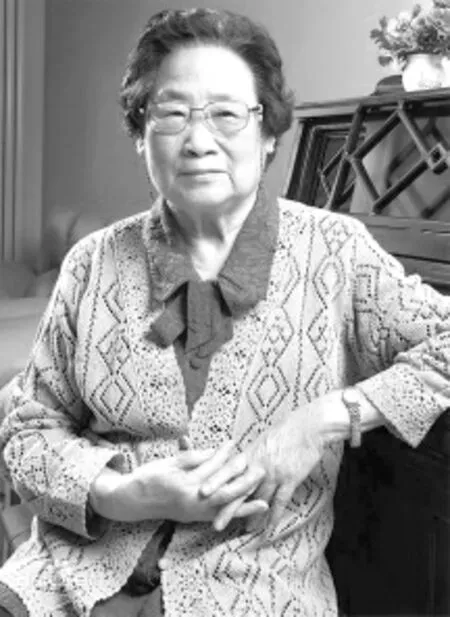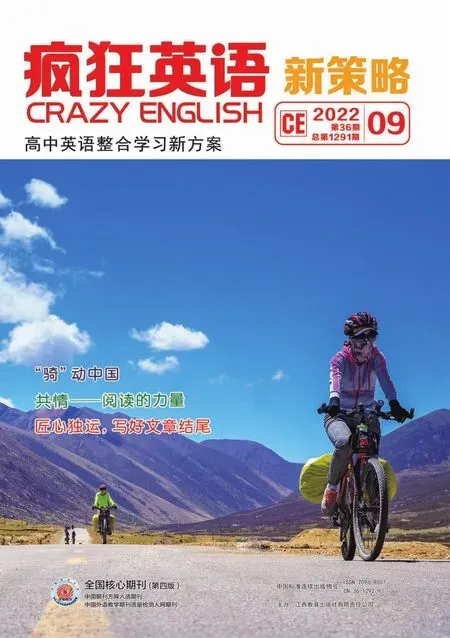人物类记叙文读写指南
河南 田国强
文体导读
人物类记叙文是以描写、介绍、叙述某一特定人物为主题的文章。 此类文章常围绕人物的背景信息、重要事迹、重大贡献进行叙述,并穿插了作者对人物的评价,在表达方式上常采用夹叙夹议的方式。在此类语篇中,涉及的人物常包括杰出人物、名人、普通人,以及奇人等。 高考考查的人物均为具有正能量的人物。

策略导航
1. 巧用彩笔细品文章。 借助彩色笔对文本中的不同部分做标注。 例如,用紫色笔标注能够吸引你的开头句,用绿色笔标注段落的主题句,用红色笔标注概括性的事件叙述,用黄色笔标注细节描写,用蓝色笔标注对人物的评价,等等。 写作时,根据标注的情况,进行仿写。
2. 利用“ABCDE原则”搭建文本框架,搭建读写支架。 “ABCDE原则”是人物类记叙文常采用的一种写作视角,但有些文章并未完全包括“ABCDE”五种要素。 在“ABCDE原则”中,A为Admiration,B为Background,C为Characteristics,D为Deeds,E为Evaluation。 在阅读人物类记叙文时,利用“ABCDE原则”有助于我们梳理和整合人物信息,感知人物形象,分析人物品行。 在写人物类记叙文时,我们可以利用“ABCDE原则”对文章进行布局,同时还要应用正确的时态和人称。

文章结构 行文视角Opening ●Admiration:对人物进行赞美Body Ending●Background:人物的背景信息√Birth√Education√Identity√Appearance……●Characteristics:人物的性格特征●Deeds:人物的主要事迹√Event 1√Event 2√Event 3……Evaluation:对人物进行评价,回应开头
素材导背
enthusiastic 热情的
hard-working 工作努力的
optimistic 乐观的
aggressive 有进取心的
compassionate 有同情心的
independent 独立的;有主见的
selfless 无私的
ambitious 有雄心的
dedicated/devoted 有奉献精神的
confident 自信的
considerate 体贴的
detached 超然的
cooperative 合作的
faithful 忠诚的
creative 有创造力的
well-educated 受过良好教育的
generous 慷慨的
industrious 勤奋的;勤勉的
modest 谦虚的
responsible 负责任的
caring 关心他人的
knowledgeable 知识渊博的
capable 有能力的
patriotic 爱国的
warm-hearted 热心的
be born into a poor/rich family 出生在一个贫穷的/富裕的家庭
show great interest in 对……表现出浓厚的兴趣
graduate from 毕业于……
devote oneself to 致力于……
bury oneself in 使……沉浸于
make a great contribution to 对……做出重大贡献
be regarded as 被当作……
be honored as 被誉为……
be well known for 以……出名
never seek fame or praise 从不追求声誉或赞美
promote the exchange of different cultures 促进不同文化的交流
one of the greatest women in the 20th century 二十世纪最伟大的女性之一
a symbol of success 成功的象征
wear a big smile 面带灿烂笑容
be striving for greatness 为伟大而奋斗
be responsible for 对……负责
stick to one's dreams 坚持某人的梦想
set sth as one's ultimate goal 把某事作为某人的终极目标
live simply and be helpful to others简单生活,乐于助人
set a good example to sb 为某人树立了一个好榜样
inspire sb to move on 激励某人继续前行
案例导练
An innovator of traditional Chinese medicine
中国传统医学的创新者
Tu Youyou is China's first native female scientist to receive a Nobel Prize in the field of science. She believes that her greatest achievement is not winning the Nobel Prize but having the opportunity to demonstrate the benefits of traditional Chinese medicine on the international stage.
Tu was born on December 30, 1930 in Ningbo, Zhejiang Province, China. At the age of 16, she suffered from tuberculosis(肺结核), which forced her to take a two-year break from school to receive treatment.This setback prompted her to pursue an education in medicine. Between 1951 and 1955,Tu attended Beijing Medical College, where she learned to classify medicinal plants, extract bioactive chemicals, and determine their chemical structures.
The early 1960s witnessed a major threat of malaria. More than 200 million people suffered worldwide. In the light of this, in 1967, an operation called “Project 523” was launched to find a cure for malaria. Eventually, she was appointed as the head of “Project 523”.
Inspired by traditional Chinese medicine, Tu Youyou began her research by screening (筛选) traditional Chinese herbs in the hope of identifying a potential anti-malarial ingredient. Her team examined 640 transcriptions (抄本) from a list of 2,000 traditional Chinese recipes. They extracted and tested 380 herbal compounds. However, after repeated trials, the results remained far from satisfactory. So she and her research team changed their extraction method. Eventually, they were able to extract a highly effective antimalarial compound, which was later considered as artemisinin, or qinghaosu in Chinese.To test the strength of artemisinin, a human trial was necessary. Tu volunteered to be the first human recipient.

Even with the discovery of artemisin, things were not easy. In the 1970s, many pharmaceutical (制药的) factories ceased production; sanitization was limited, and boiling equipment was scarce. Under these circumstances, Tu and her team continued to overcome the mounting pressure and discovered new ways to conduct their research. They made enormous sacrifices during their research. Although Tu was able to complete her work, she was ultimately diagnosed with toxic hepatitis (肝炎).
The discovery of artemisinin and dihydroartemisinin (二氢青蒿素) proved to be the turning point in the battle against malaria. Although Tu has received multiple international awards and is recognized for her achievements, she continues to maintain a low profile and attempts to improve her work.
Ⅰ. 阅读自测
1. Which achievement can be the greatest in the eyes of Tu Youyou?
A. Winning the Nobel Prize.
B. Being China's first female scientist.
C. Entering the field of science.
D. Showing the benefits of traditional Chinese medicine internationally.
2. What was the original strike to Tu Youyou according to paragraph 2?
A. Dropping out of school.
B. Suffering from tuberculosis.
C. Being born into a poor family.
D. Failing to identify medicinal plants.
3. What can be inferred about Tu Youyou's research according to the text?
A. It was completed by Tu Youyou in the 1970s.
B. It was inspired by modern Western medicine.
C. It was started due to the breakout of malaria in China.
D. It was carried out under some unfavourable circumstances.
4. What can best describe Tu Youyou according to the text?
A. Diligent, smart, patriotic and sensible.
B. Determined, creative, honest and loyal.
C. Devoted, persevering, brave and modest.
D. Clever, positive, upright and independent.
Ⅱ. 语言汲取
(一)介绍人物的核心表达
1. 人物背景
innovator 创新者
female scientist 女性科学家
setback 挫折
head 负责人
be born on...in 在(某一天)出生于(某地)
suffer from 遭受……;受……之苦
take a two-year break from school 休学两年
receive treatment 接受治疗
attend college 上大学
pursue an education in medicine 追求医学方面的教育
2. 主要事迹及重大活动
launch a project 启动一个项目
find a cure for 寻找……的治疗方法
be appointed as 被任命为……
be inspired by 受……的启发
screen traditional Chinese herbs 筛选传统中药
in the hope of 希望……
identify a potential anti-malarial ingredient 找出一种潜在的抗疟疾成分
after repeated trials 经过反复的试验
far from satisfactory 远远不能令人满意
extract a highly effective anti-malarial compound 提取出一种高效的抗疟疾化合物
test the strength of artemisinin 测试青蒿素的强度
human trial 人体试验
volunteer to do 志愿做……
the first human recipient 第一个人类接受者
overcome the mounting pressure 克服不断增加的压力
discover new ways 寻找新的方法
conduct one's research 进行某人的研究
make enormous sacrifices 做出巨大的牺牲
turning point 转折点
continue to do 继续做……
maintain a low profile 保持低调
attempt to improve one's work 努力改进某人的工作
3. 人物成就
receive/win a Nobel Prize 获得诺贝尔奖
receive multiple international awards 获得多个国际奖项
be recognized for 因为……而得到认可
demonstrate the benefits of traditional Chinese medicine on the international stage 在国际舞台上展示了中国传统医学的好处
4. 其他
have the opportunity to do 有机会做……
force sb to do 迫使某人做……
prompt sb to do 促使某人做……
in the light of 鉴于……
at the age of 在……岁时
in the 1970s 20世纪70年代
cease production 停止生产
under these circumstances 在这些情况下
(二)精彩表达
1. At the age of 16, she suffered from tuberculosis, which forced her to take a twoyear break from school to receive treatment. 16岁时,她患上了肺结核,这迫使她休学两年以接受治疗。
本句中,which引导的是一个非限制性定语从句,用来指代主句she suffered from tuberculosis。
2. The early 1960s witnessed a major threat of malaria. 20世纪60年代初见证了疟疾带来的主要威胁。
动词see、witness、find、notice、observe、discover等可用于拟人化的用法, 使无灵名词所表达的事物具有人的情感、情态或动作,使抽象的概念具体化,使静止的物体具有动态的人格化效果。
3. Although Tu has received multiple international awards and is recognized for her achievements, she continues to maintain a low profile and attempts to improve her work.尽管屠呦呦获得了许多国际奖项并因其成就受到认可,但是她一直保持低调,努力改进自己的科研工作。
本句中,although引导的是一个让步状语从句,she continues to maintain a low profile and attempts to improve her work为主句部分,to improve her work为动词不定式作宾语。
Ⅲ. 句式仿写
1. 屠呦呦自愿成为首位接受者,以测试青蒿素的强度,这使她成为一位真正的女英雄。
Tu Youyou volunteered to be the first human recipient to test the strength of artemisinin, ________________.
2. 在电影结尾,他们遭遇了孤独和失败。
The end of the movie ________________. (find)
3. 尽管你的数学取得了很大的进步,但你还是应该继续竭尽全力。
________________, you should keep trying your best.
Ⅳ. 写作实践
近日,疯狂英语杂志社举办了主题为“My heroine”的征文活动。 请你根据以下要点,写一篇短文投稿。
1. 你心中的女英雄是谁;
2. 你把她当作女英雄的原因;
2. 她的主要事迹。
注意:
1. 词数80左右;
2. 可以适当增加细节,以使行文连贯;
3. 至少需要使用两个本文中解析过的句式。
My heroine
_________________________________________________
_________________________________________________
_________________________________________________
_________________________________________________
_________________________________________________
_________________________________________________
_________________________________________________
_________________________________________________
评价导思

A self-assessment checklist for my narrative reading 1. 阅读本文前,我认真了解了人物类记叙文的文体知识。 □Yes □No 2. 在阅读过程中,我会借助彩色笔对文本中的不同部分做标注。 □Yes □No 3. 在阅读过程中,我会应用“ABCDE原则”梳理文章。 □Yes □No 4. 这篇文章中我最喜欢的部分是_____ _。□Background □Character □Deeds □Evaluation 5. 读完这篇文章后,我会尝试着对我熟悉的人物进行介绍和评价。 □Yes □No 6. 读完这篇文章后,我会花费_____ _的时间来读完一篇大约350词的人物类记叙文。□5分钟 □7分钟 □9分钟 □其他7. 本次读写活动后,我会学习科学家的优良品质。 □Yes □No 8. 为了阅读更多类型的人物类记叙文,我需要_____ _。□加倍努力 □持之以恒 □坚持目标 □形成高效的读写策略9. 在接下来的时间,我会读一本叫作________________ _的人物传记。

